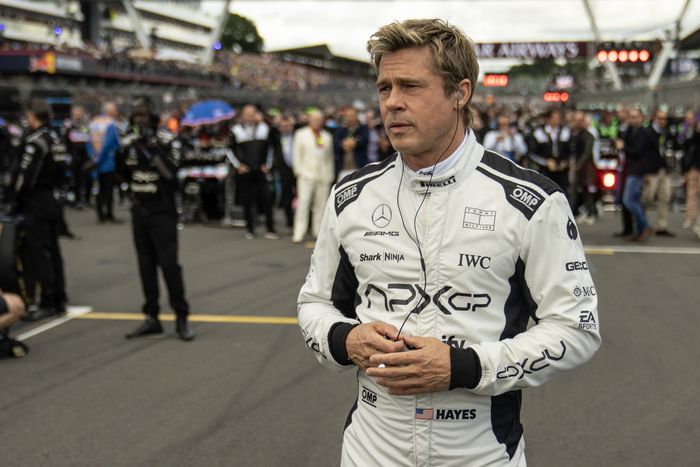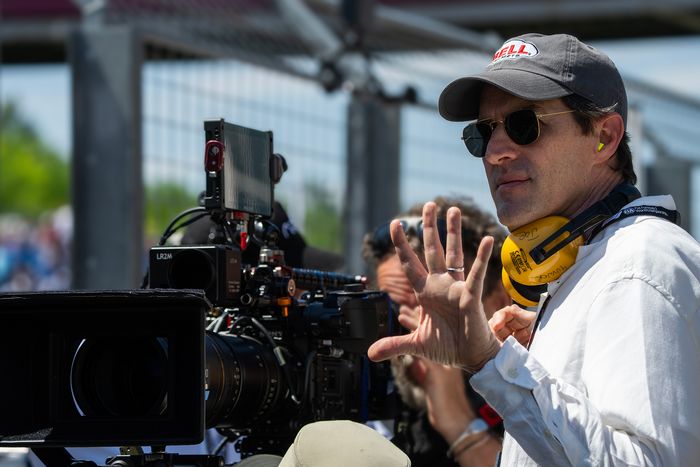According to director Joseph Kosinski, one of the inspirations for F1: The Movie came the day he witnessed a group of Mercedes engineers create a race car at breakneck speed right before his eyes. “Before I made this movie, I thought standing on the deck of an aircraft carrier between two F-18s launching simultaneously would be the most thrilling thing I’d ever witness,” says the filmmaker, who had a massive Oscar-nominated global hit with 2022’s Top Gun: Maverick. “But then I stepped into the Mercedes garage at Austin during the Grand Prix and watched these engineers build a car in real time. They literally took pieces out of boxes that had just come from the factory and assembled the car, and then I watched Lewis Hamilton climb into it, becoming part of the car. Then it drops to the ground, drives out, and sets a lap record.”
It was sights like this that convinced Kosinski to tackle the world of Formula One racing. The director has always been captivated by the relationship between humans and technology, and this idea appears early in F1 through the film’s initial presentation of rookie driver Joshua Pearce (Damson Idris), a young man surrounded by the latest in high-tech gear. When we first see him, Joshua is fully integrated into the car, a figure seemingly as much a part of this machine as its wheels or its engine. When he works out, he is connected to sensors that measure his breathing and body levels. When he drives, dots on screens relay how he’s doing and will do at each part of the track. Joshua is a person, but he is also a blip, a readout, a series of numbers battling against more numbers.
Into this world strolls Sonny Hayes (Brad Pitt), a rough-around-the-edges veteran driver who (literally) crashed out of Formula One several decades ago. When he works out, he does it outside, jogging on the track. While Joshua strengthens his neck muscles (a necessity for Formula One drivers) with high-end workout equipment, Sonny simply leans his head against the hard edge of a bed in his room. Sonny is superstitious and temperamental and unpredictable. He doesn’t bend to the machines; he makes them bend (and sometimes break) to his will. When he races, he doesn’t just go fast — he pulls disruptive maneuvers that threaten to get him disqualified but also give him an edge.

Brad Pitt in F1. Photo: Scott Garfield/Warner Bros./Apple Original Films
In many ways, this is just a typical summer blockbuster setup. We saw it in Top Gun: Maverick, with the Tom Cruise character’s insistence that the only way to complete the impossible mission at hand was with real human pilots who could improvise and push themselves in ways that others couldn’t. Hell, we saw it in Rocky IV, with Rocky Balboa climbing snowy mountains and carrying logs and sawing trees while Ivan Drago worked out in a futuristic palace of slick gear and digital readouts. It’s a familiar part of underdog stories, of the kind Kosinski often finds himself drawn to. (Another inspiration for F1, he says, was watching the first season of the reality series Formula One: Drive to Survive that focused on the last-place racing teams.) Joshua and Sonny aren’t adversaries, however. They’re on the same team, but each drives his own car, which makes them both teammates and rivals who must learn to work together.
In the hands of another director, conflict like this would be confined to dialogue exchanges or become a blunt story element. But ever since his feature directing debut, Tron: Legacy (2010), Kosinski has established himself as a filmmaker uniquely able to convey the emotional textures of living in our tech-drenched world. His Tron sequel arrived 28 years after the Disney original, which had revolutionized visual effects back in 1982 with its action-adventure set inside a video game. The first Tron had played out as a series of face-offs featuring glowing figures against a black background, replicating the blank environment of an arcade screen. By contrast, Kosinski’s follow-up plays out against eternal night, with dark mountains looming against deep-black skies with ominous gray clouds. It’s all supposedly the same game, but now the negative space has become existentially charged: Coupled with a story line about digital avatars who seek to replace the humans in whose images they were shaped, the movie possesses an aching sense of oblivion.
Oblivion also happens to be the title of Kosinski’s second film, in which Cruise plays a sentry watching over a devastated Earth that has become inhospitable to all life. He realizes, eventually, that he is a clone, part of an army sent by an unseen alien artificial intelligence to wipe out humanity. The planet has been emptied not because people have fled, but because they’ve been exterminated. The forbidding night skies of Tron: Legacy become the forbidding, desolate landscapes of Oblivion. In the visually striking finale, Cruise’s character travels on a suicide mission to a space station hovering above Earth and enters the alien force’s lair — which is basically a giant hall, somehow more terrifying for its enormous emptiness. The alien intelligence is represented by a giant floating pyramid, opaque and unknowable; as far as we can tell, these aliens are defined by their nothingness.
Kosinski, who trained as an architect before becoming a filmmaker, has an eye for how space defines character and emotion. That was, in many ways, what made Top Gun: Maverick so powerful. It’s a rousing fighter-jet adventure, sure, but it’s also a somber meditation on Tom Cruise’s star persona and America’s changing role in the world. It has an unshakable aura of doom: Cruise’s character often appears like a ghost, which is why some proposed the whole thing might be a death dream. Rarely has a billion-dollar blockbuster felt so sad and lonely. Even if he doesn’t die, Maverick seems on the verge of extinction. (This is a literal line in the movie: “The end is inevitable, Maverick. Your kind is headed for extinction.”) A recurring point is the impending replacement of pilots by drones. All these movies — including Kosinski’s devastating 2017 firefighting drama, Only the Brave, in which a group of men fight a losing battle against apocalyptic wildfires that consume entire mountains, and his futuristic 2022 Netflix thriller, Spiderhead, about a tech bro (Chris Hemsworth) who controls and negates people’s emotions through a series of futuristic chemicals and devices — are steeped in the melancholy romance of the post-human. Kosinski’s characters might fight against a universe that could easily go on without them, but they’re also kind of drawn to it. He captures both the terror and the fearsome beauty of a world that doesn’t need us anymore.
Click here to preview your posts with PRO themes ››

Director Joseph Kosinski on the set of F1 The Movie. Photo: Scott Garfield/Warner Bros./Apple Original Films
“We’re all confronted or struggling with technology,” Kosinski says. “It’s a constant battle. But we still matter in this world that we live in. I think that’s a very relatable idea.” As a director, Kosinski uses that tech to his advantage. While filming Maverick, he and his cinematographer, Claudio Miranda, took inspiration from real Navy pilots who placed GoPros on their canopies and filmed their training exercises. The production devised a system of fixed cameras that would shoot actors as they went up in real fighters. For F1, Kosinski asked himself, Would it be possible to shoot a Formula One movie while a Grand Prix is actually happening? That meant finding a way to make these cameras even smaller and more versatile, giving the director enormous access to what happens in the vehicle and to the actors. “It was a year of research and development,” Kosinski says. “The camera system didn’t exist that we needed to shoot this movie, so we had to invent it. Working with Sony, we took the Top Gun: Maverick system and miniaturized it, lightened it, and stripped it to its bare minimum.”
On Maverick, Kosinski had rehearsed the actors on the ground, in a plywood mock-up of a plane, and then sent them up in the jets to effectively prompt and direct themselves. For F1, he sought more control and versatility. “I really wanted to move the camera and to control it, in real time. And since we’re shooting in IMAX format, the depth of field is shallow enough that I wanted to be able to pull focus — to go from a car that’s chasing him to Brad’s eyes,” he says. The wireless system they developed allowed the director to see the image in real time, pan the camera, and change focal length in a car that’s going almost 200 miles an hour.
As the vehicles zoomed around the world’s most famous race tracks (the production spent the better part of two years following Formula One around the world and shooting at actual Grand Prix races, with the actors driving real race cars), the crew maintained communication by placing their master control in the center of the field, always within a half mile of where the cars would be as they looped around the crew. “I had 16 different camera positions, and I could run four positions simultaneously,” Kosinski says. “So we had two cars running four cameras each at a time. I had eight feeds, and then I had all the knobs for panning them. So it was like live TV: ‘Pan three, pull focus, two.’ It was just a whole different way of doing the job on race day.”
The settings and spaces of F1, however, are unlike the other worlds Kosinski has depicted. For starters, no one would ever describe them as empty or desolate. Quite the opposite. Filming in front of real audiences, alongside real racers and real pit crews, the director crowds the screen with people. He says he found the teamwork of Formula One fascinating: “There’s a thousand people that go into this one guy in this one machine on this weekend.” In F1, the people aren’t just part of the machine, sometimes they are the machine, functioning in unison and trying to shave off as many split seconds as possible from pit stops and finish times. In an odd way, that extends to the audience as well. With the sheer number of angles and positions Kosinski captures in and around the cars, he achieves a sense of total immersion for the viewer. We feel as if we can see every part of the vehicle — almost like we ourselves have become part of the machine.
But F1 still also works that paradoxical longing for oblivion, which ultimately every Kosinski character seems to circle around. Sonny, raised from a young age to be a driver, reflects on how he lost his love for racing after a catastrophic accident many years ago, and how he yearns to find it again. “It’s rare,” Sonny says, “but sometimes, there’s this moment in the car when everything goes quiet.” It’s a dream of both isolation and freedom. “I can see everything, and no one — no one — can touch me.” It’s a relatable feeling for a world in which escape is only possible through the very things that make escape necessary. If Maverick at times felt like a ghost trying to find his way back to being a man, Sonny seems to be a man trying to find his way back to being a ghost. What makes Kosinski’s work singular is that he finds the inexpressible beauty in that ever-shifting dance.


